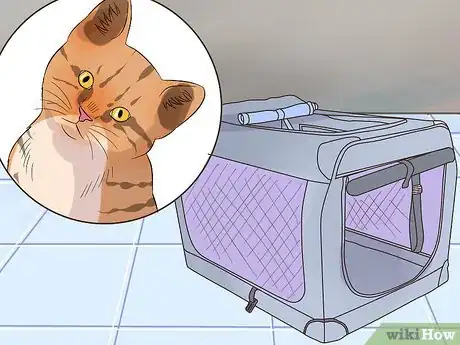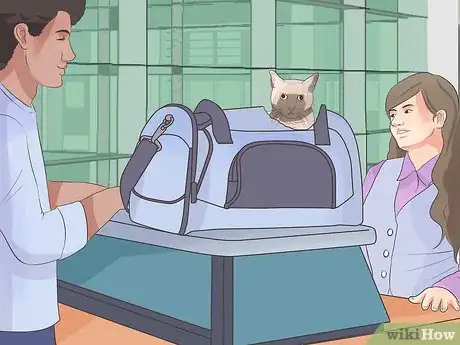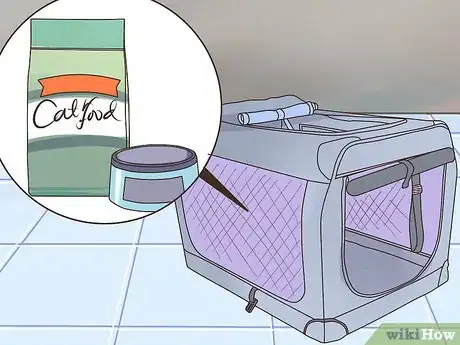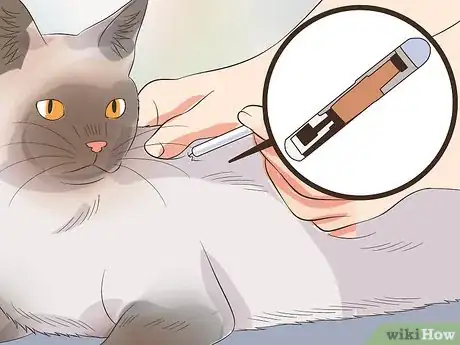This article was co-authored by Pippa Elliott, MRCVS. Dr. Elliott, BVMS, MRCVS is a veterinarian with over 30 years of experience in veterinary surgery and companion animal practice. She graduated from the University of Glasgow in 1987 with a degree in veterinary medicine and surgery. She has worked at the same animal clinic in her hometown for over 20 years.
There are 13 references cited in this article, which can be found at the bottom of the page.
This article has been viewed 181,048 times.
Your cat is part of the family. If you decide you need to ship your cat, it's a scary prospect. However, you do have options available to you. Mainly, you can ship through the airlines or through private pet shipping services.
Steps
Shipping With an Airline
-
1Pick a date. Most of the time, you can't book a cargo flight ahead of time. However, you can call and reserve a space on your preferred flight and airline. It's best to call and talk to someone so you have all the details worked out.[1] Note that you will pay for your pet the day of shipping.
-
2Ship during the week. In many cases, your cat will get better service during the week because more employees are on. Therefore, try to schedule it so your cat can leave on a weekday.[2]Advertisement
-
3Learn the company's guidelines. Each airline has different requirements when it comes to pet shipping, though many are the same for each company. Nonetheless, check with the airline to see what it requires or prohibits.
- For instance, American Airlines prohibits the shipment of snub-nosed breeds, such as Persian, Exotic Shorthairs, or Burmese cats.[3] This restriction is for the safety of your pet, as pets with snub-noses can be susceptible to oxygen deprivation and heat stroke.[4]
- Another American Airline's guidelines is the crate and pet can't be over a hundred pounds. While that would be hard to do with a cat, you want to make sure your crate isn't too heavy.
-
4Find a good kennel. Airlines also have certain requirements for the kennel. For the most part, the transport kennel usually must be rigid, escape-proof, and meet other requirements, such as ventilation on at least 3 sides for domestic flights. However, each airline may have specific requirements.[5]
- For instance, on American Airlines, the kennel can't be bigger than 36 inches (91.4 cm) long, 26 inches wide, and 28 inches high. Nonetheless, your pet should be able to sit up, turn around, and lay down.
- You may also need to provide water and food dish that is securely attached to the inside of the kennel yet can be reached from the outside.
- Most also require you to provide bedding that can absorb any bathroom mistakes your cat does in the kennel. For instance, towels and shredded newspapers are suggested options.[6]
-
5Get a health certificate. Most airlines require that you have your pet's health certified within the last 10 days. If it happens to have a return flight, it must also have a health certificate within 10 days of that flight.[7]
- Your vet will provide the health certificate once he or she checks the animal out. Make sure to ask your vet in advance to see if he or she provides this service.
- Often, you'll need two copies of the health certificate.[8]
-
6Decide whether to sedate your cat. Many cats do not travel well, and you may be wondering whether you should sedate your cat for flying. You can do so. However, most airlines discourage it. The main reason it is discouraged is that high altitude can change how the medication affects your cat. Talk with your vet about what's best for your cat.[9]
-
7Label the container appropriately. You need to write "LIVE ANIMAL" on the top and at least one side. You also need to add "THIS SIDE UP" with arrows on two sides.[10]
- You also must provide other pertinent information, such as when the cat was last fed and when it should be fed again. In some cases (American Airlines), the airlines recommend that you feed the cat within four hours of the flight,[11] while other airlines (Delta) recommend you feed the cat a light meal no less than four hours before the flight.[12]
- When labeling the container, you need to note if the cat is sedated or not. You'll need to provide information on how the cat was sedated, including the weight of the cat, how much medication was given, when it was given, the generic name of the medication, and how it was given to the cat.
-
8Check the weather. Most airlines will only ship when the temperature is in a certain range for the protection of your animal. For instance, American Airlines mainly ships animals when the temperature is between 45 °F (7.2 °C) and 85 degrees Fahrenheit.[13]
- This measure is also to protect your animal, as your animal will be outside while loading the plane.
- If your vet will certify that your animal is acclimated to it, some airlines will let you go below this range.
-
9Drop your pet off. Your airline should have a list of drop-off locations for pets, and it can be different from passenger check-in. Ask your airline for the drop-off location, or check online.[14]
- Ask about any extras the airline offers to keep your mind at ease. For instance, Delta offers GPS tracking devices for an extra fee, so you always know where your cat is.[15]
-
10Have someone ready for pickup. Your animal will need to be picked up on the other end. Like drop off, where you pick your pet up varies by airline and and airport. Call or check online to find out where pickup is on the other end.[16]
- Don't forget to notify the airlines who will be picking up your cat if it is not you.
- Often, pickup will be in the cargo area.
Transporting With a Shipping Company
-
1Fill out the contract and information form. Most companies will have you fill out a form about you and your animal. Often, this form is also a contract that you will follow the company's guidelines for shipping a pet.[17]
- Mostly, you will say who's going to be providing the health certificates for your animal and that the company has the authority to charge your card.
- You'll also agree to abide by the company's rules, such as providing an appropriate kennel or choosing an appropriate kennel from the company for your pet.
-
2Get an appropriate kennel. By USDA regulations, your cat needs to have enough room in its kennel when traveling. It should be able to stand up, turn around, and lay down fully. In other words, it should be half a foot longer and half a foot taller than your pet. When you call or go online for an estimate, use these estimates to choose a kennel size for your cat.
- In some cases, you will need to provide your own crate. In other cases, the company will provide a kennel for the pet. Check with your company to see what it does.[18]
-
3Obtain a health certificate. Your vet needs to certify that your cat is in good health for travel. Most vets provide this service, but call ahead of time to find out. Your health certificate must be completed within 30 days of travel for some companies, but always check with the company you're shipping with.
-
4Follow the rules for airlines. In some cases, the shipping company will provide transportation to an airport, where your pet will be put on a plane. In that case, you need to follow the rules for your particular airline, such as providing food and water bowls attached inside the crate or kennel.[19]
-
5Call to set up travel. Call your preferred transport service to set up travel. You can find pet transport services on the internet. Once you pick one, you can talk to a representative to decide how you want your pet to travel.[20]
- Some services offer ground and air transport, while others only offer air. If you have a snub-nose cat, you'll likely need to send it by ground transport.
- Some services also offer private pet transport, meaning your pet will be the only one being transported.
-
6Make sure you add a tag to your cat. Even with trusted transportation services, things happen. Make sure your cat has a collar with your name and number on it so you can be called if the cat is lost and found somewhere else. You might also consider getting your cat microchipped, so someone can find your information even if your cat loses its collar.[21]
- A microchip is just a tiny chip your vet places under your cat's skin. It can be scanned to provide information from a database. You just need to be sure to update your information online.
-
7Decide where your cat is going to be delivered. These pet services typically go door to door, so you need to know where your pet is going. If you don't have someone on the other end, you can arrange for a vet to kennel your cat until you arrive to pick him or her up.
References
- ↑ http://www.iata.org/whatwedo/cargo/live-animals/pets/Pages/index.aspx
- ↑ http://www.iata.org/whatwedo/cargo/live-animals/pets/Pages/index.aspx
- ↑ https://www.aacargo.com/learn/animals.html
- ↑ http://www.humanesociety.org/animals/resources/tips/traveling_tips_pets_ships_planes_trains.html
- ↑ https://www.aacargo.com/learn/animals.html
- ↑ https://www.deltacargo.com/PetShipment.aspx
- ↑ https://www.united.com/web/en-US/content/travel/animals/procedures.aspx
- ↑ https://www.aacargo.com/learn/animals.html
- ↑ https://www.deltacargo.com/PetShipment.aspx
- ↑ https://www.deltacargo.com/PetShipment.aspx
- ↑ https://www.aacargo.com/learn/animals.html
- ↑ https://www.deltacargo.com/PetShipment.aspx
- ↑ https://www.aacargo.com/learn/animals.html
- ↑ https://www.united.com/web/en-US/content/travel/animals/petsafe-drop-off-and-pick-up-locations.aspx
- ↑ https://www.deltacargo.com/PetShipment.aspx
- ↑ https://www.united.com/web/en-US/content/travel/animals/petsafe-drop-off-and-pick-up-locations.aspx
- ↑ http://www.petaircarrier.com/pet-travel-services/downloads-and-forms/
- ↑ http://www.petaircarrier.com/pet-travel-tips-crates/crating-requirements/
- ↑ https://www.petaircarrier.com/pet-travel-tips/food-water-pet-travel/
- ↑ http://www.petaircarrier.com/pet-travel-tips-crates/pet-travel-questions/
- ↑ http://www.humanesociety.org/animals/resources/tips/microchips.html
About This Article
To ship a cat, make sure to call the airline ahead of time to reserve a space for your cat on your preferred flight. Within 10 days of the flight, take your cat to the vet to obtain a health certificate that you’ll need to give to the airline. On the day of the flight, put your cat in a kennel that is rigid, has good ventilation, and meets all the airline’s requirements. Additionally, label the kennel with “LIVE ANIMAL” on the top and sides. Finally, drop your cat off at a designated location at the airport and confirm that someone is ready to pick it up on the other end. For advice from our Veterinary reviewer on how to sedate your cat to make them more comfortable while being shipped, read on!



















-Step-11-Version-6.webp)
















-Step-11-Version-6.webp)



































